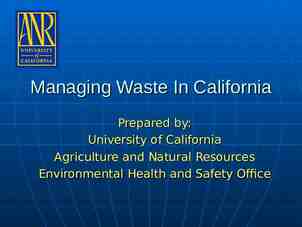Overview of Networks Alisa Neeman Based on, and using images from
12 Slides119.62 KB
Overview of Networks Alisa Neeman Based on, and using images from An Introduction to Computer Networks Peter L Dordal CC 3.0 https://creativecommons.org/licenses/by-nc-nd/3.0/
Key Concepts (Vocabulary) Layer Model Bandwidth Packets Datagram Forwarding Network Topology (Graphs) Routing Congestion
Client Server Client: requests data or service Server: provides data or service Ethernet: most common way to link computers on a LAN using wires Local area network (LAN)
Layers Refers to the various pieces of software and hardware that help data cross the network. Refers to information in each data packet necessary for it to cross the network, such as the sender’s and receiver’s addresses. Refers to protocols: rules for communication that enable orderly transport of data.
5-Layer Model Application: For example, HTTP, Hypertext Transport Protocol, for web pages, includes encryption/decryption TCP: Transport Control Protocol ensures all the data packets arrive at Port Number, in correct order, manages session (connect & disconnect) IP: Internet Protocol ensures that the packets are routed to the correct IP address on a WAN (wide area network) such as the World Wide Web. (IP Address) Logical LAN or Link: software that routes packets within a local area network (LAN) based on client network card addresses (MAC address) Physical LAN: wires, routers, access points, network interface cards, wireless channels Application TCP IP Link Physical LAN
Bandwidth Rate at which data is transmitted across a network Units: Mbps: megabits (106) per second Gbps: gigabits (109) per second For example, a LAN might use 100 Mbps Ethernet. A cluster (computers networked together for parallel computation) might have gigabit or 10 gigabit Ethernet.
Packets or Datagrams “Modest-sized buffer” of data that will get transmitted over network links In addition to the content, the packets contain headers; space reserved for address and protocol information. header data Since we are using a layered model, each layer has its own header. Sizes of packets and headers is in units of octets (8 bits), i.e. bytes. header1 header2 data
Packet name and size by layerApplication TCP Link layer: frame Maximum size for Ethernet frame: 1518 bytes IP Link Physical LAN Transport layer (TCP): segment Typical header sizes Ethernet: 14 bytes header1 header2 data IP: 20 bytes TCP: 20 bytes Application: depends on the application! Much of this course will be studying what is in each header, and how each protocol uses the header information to handle network traffic.
How Packets Get Where They Need to Go Attached to the network are routers and/or switches and/or gateways with incoming links and outgoing links (a link is a wire) The router will have a routing table to decide which outgoing link the packet should take to get closer to their destination Source Peter L Dordal CC BY-NC-ND 3.0
Routing Tables for S1 and S2 S1 S2 destination Next hop destination Next hop A C B 0 1 2 A,C D E 0 1 2 D E 2 2 B 3 Source Peter L Dordal CC BY-NC-ND 3.0 How would a packet go from A to E?
Stateless “To improve robustness of the communication system, gateways are designed to be stateless, forwarding each IP datagram independently of other datagrams. As a result, redundant paths can be exploited to provide robust service in spite of failures of intervening gateways and networks.” RFC 1122 State means data that you save, in a variable or file. The stateless idea is that the routers don’t have to remember anything about packets going by. Robust means it doesn’t fail or crash.
Congestion Wired or Wireless, it is a shared medium with many clients and servers Congestion: hardware, such as a router can get overwhelmed by too much data Algorithms needed to throttle down at times, maintain fairness for everyone, etc.

















